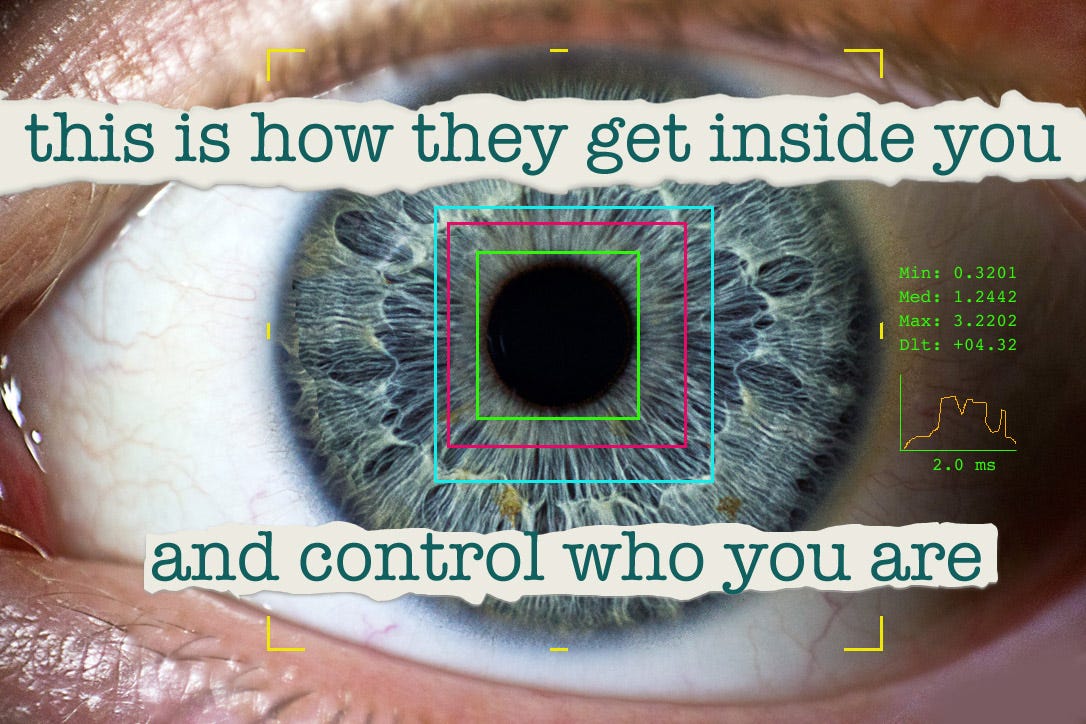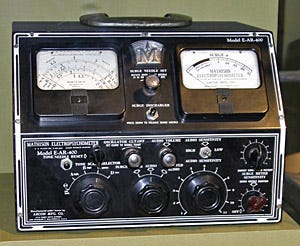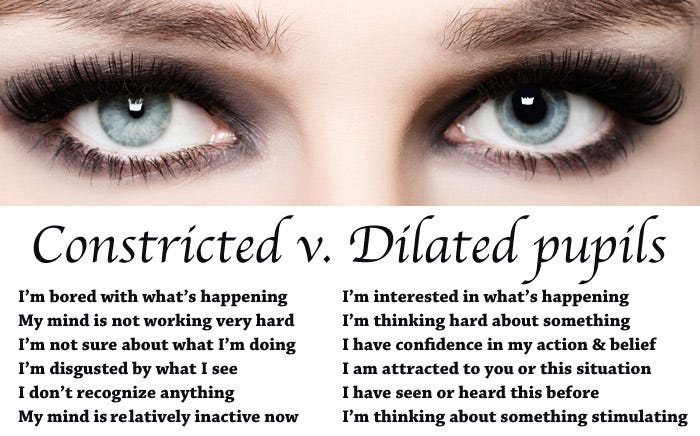Something you need to know...
If "they" succeed, you probably won't even notice, let alone care, when your most intimate and private thoughts are accessed by a new technology just coming on the scene. That's because the same technology -- called pupillometry -- can not only accurately read your mind but can actually change it.
In this article, you will learn that the science of pupillometry -- measuring the changes in the diameter of your pupils in real time -- has the ability to reveal mental activity associated with everything from sexual preference, future job peformance and repressed memories to the condition of your autonomous nervous system, your overall health and what medication or drugs you have taken.
But unfortunately it doesn't stop there.
It is a known fact that the mind is extremely receptive to new ideas during certain phases of activity associated with processing new or unexpected sensory stimulation. Ordinarily, these brief mental states are only observable with an fMRI or less accurately with an EEG. Taking advantage of these "enhanced learning" states has therefore been impractical.[15]
It has now been shown that these same mental states are reflected in the variable size of the pupil which, as it turns out, varies not only from adjustments to light and darkness, but to the arousal of a certain region of the brain, the locus coeruleus -- a kind of neural "hub" active in processing our "working memory" or RAM.
The ability to precisely monitor pupil size in real time, while silmultaneously presenting visual and/or audio stimulation, presents an opportunity to both monitor and control the belief systems of the subjects. Private and intimate thoughts can be ascertained and cataloged by presenting specific images or sounds and recording the pupillary response. Experiments have already proven this to be effective.
By monitoring for the "enhanced learning" neural pattern, reflected in pupil size variations, a pre-determined suggestion can be delivered by the same device at precisely the most effective moment. The suggestion need not be consciously perceived to be effective. It can be audio, visual or both. Subliminal cues are effective.
This matter should become relevant when you consider that technology such as SmartPhones and computer "glasses" are equipped with hi-resolution cameras and have the audio and visual display plus the computer power to effectively do this, here and now.
Just the facts, please.
Changes in pupil size have been known to be associated with aroused states in humans for a very long time [3]. The observation was first implemented by the Canadian government in the early 1950s in a device that was sarcastically referred to as the fruit machine. This was a crude device by today's standards and measured the pupil size of military recruits while showing them pictures of naked men and women. It was designed to ferret out homosexuals from joining the RCMP (mounties) by flagging those whose pupils dilated to the images of males.
The "fruit machine" was employed in Canada in the 1950s and 1960s during a campaign to eliminate all homosexuals from the civil service, the Royal Canadian Mounted Police (RCMP), and the military. A substantial number of workers did lose their jobs. Although funding for the "fruit machine" project was cut off in the late 1960s, the investigations continued, and the RCMP collected files on over 9,000 "suspected" homosexuals [1].
The Canadian machine involved a bulky camera which was barely able to measure a change of one millimeter of the pupil's diameter. Experiments in the mid-60s seemed to confirm that the pupil response to naked pictures of men and women was indeed different for homosexuals and heterosexuals [4], and more recent studies have confirmed this [5], nevertheless the "fruit machine" was abandoned in the late 1960s.
Today we have the benefit of extremely accurate pupillometers [10], as they are called, that are small, transparent and digitized. Even more important is that we now have brain scanners PET and fMRI machines that can match the inner activity of our brains with observed variations and patterns in our pupil size.
We have learned that pupil dilation is an indication of a special kind of brain activity, or "hard thinking". Scientist like to compare this kind of activity with a computer's RAM memory, or active memory. This is an activity involving short term memory that gives continuity to our thoughts and allows us to, for example, multiply 9 by 12.
Mathematics is a good example of a mental problem capable of dilating your pupils. You can check this for yourself. Go to a mirror and have a friend ask you to remember and recite back six numbers. Watch your pupils. Now have your friend ask you to remember a series of seven numbers... then eight. You have reached the normal level of easy memory for most people and the mental effort required to go beyond seven digits will easily dilate your pupils.
In fact, scientists have discovered that the harder you must work to solve a problem, the wider your pupils will dilate [5,12,13].
This interesting phenomenon was recently used to communicate with patients who suffered complete paralysis and could not speak or move. They were instructed to respond "yes" by thinking of a mathematical problem while the hospital staff watched their pupils. This technique proved successful and is being used in many similar circumstances around the world.
"It is remarkable that a physiological system as simple as the pupil has such a rich repertoire of responses that it can be used for a task as complex as communication."
Wolfgang Einhauser of Philipps-Universitat Marburg in Germany.
Pupils reveal much more than "yes" or "no"
Pupil size reacts to light and darkness by changing its diameter to allow more or less light to enter the eye. Normal people have a diameter of about 2.5 to 5.0 mm. In total darkness the pupil can open up to 8.5 mm. The changes from mental activity are about 20% of these normal variations (about 0.5 mm). The ability to detect extremely small variations is the key to understanding the underlying mental processes.
Using new pupillometers and infra-red light, researchers have recently catalogued some of the meanings of various pupil responses and their mental significance.
The dangerous part...
Don't be surprised if your next big job interview begins with a seemingly harmless video presentation that you are asked to view with a pair of special glasses. These kinds of psychologically invasive pre-employment tests have become routine. Walmart has an extensive computerized questionnaire designed to reveal dishonesty and reliability. Questions like, "If you saw a fellow associate steal an inexpensive candy bar, would you report them to management?" zero in on your sense of morality and loyalty to the corporation.
In the future much more information about you will be catalogued by showing you a series of carefully chosen images while measuring your interest and reaction by assessing your pupil variance. Databases will be collected and "mined" to reveal lifestyle patterns, fetishes and character flaws.
Think this is a wild idea? Just look at what can currently be revealed by your pupil size:
Measuring the pupil diameter of subjects prior to being asked to perform a task predicted how they performed at that task. Dilated eyes correlated with bad performance because the subjects tended to over-react from higher mental stimulation. Would an employer be entitled to know this?
"A larger pupil size indicated poorer upcoming task performance, due to more variability in the decisions made once the relevant information was presented. The authors also found that certain individuals who had the largest pupils overall also tended to be the least consistent in their decisions."[6]
Pupil dilation is involuntary and cannot be faked. It will soon find application in law enforcement and security interrogations.
Your pupils will dilate if your mind recalls hearing or seeing a person, scene or event -- even if you consciously do not remember. Unconscious and repressed memories are capable of dialting the pupils.
People who have suffered brain injuries resulting in total blindness will react to a presented visual stimuli because the visual input from the eyes bypasses the visual cortex. Their subjects' pupils dilate even though they cannot see what is in front of their eyes.
Your amygdala - a walnut sized part of the brain located in both hemispheres - is capable of recognizing other people's pupil dilation even if you do not consciously acknowledge this. Pupil size is apparently so important to our interpersonal communication that we have evolved a special neural network to detect pupil size in others. [11]
If you hear a recording of the disguised voice by someone familiar to you, even if it is just a group of vocal sounds, your pupils will react to these by dilating even if you consciously do not recognize the recording.
Subjects with Alzheimers disease (AD) have a greater baseline pupil diameter than non-AD patients. This perhaps indicates that the AD subjects are, mentally at least, working harder to compensate for their deficits from the disease. [9]
If you are asked to make a difficult decision, your pupils will dilate while you ponder each option. The more difficult the task, the larger the pupil dilation. But when your mind has chosen the option your pupils immediately constrict to baseline, even if you are not yet aware that you have already decided. Also, when asked to report your decision, if you are unsure about your choice your pupils will begin to waver in size. If you are confident, your pupils will remain dilated. [14]
If the problem is harder, the pupils dilate more. But if a person becomes over worked (mentally) and reaches 125% of their capacity they literally overload and their eyes constrict. All further attempts at solving the problem are finished. [16]
But the most dangerous application of pupillometrycomes from research revealed in 2013 by the US National Institute of Health [7]. The study showed that when presented with novel stimulation the pupil will suddenly dilate as mental attention is heightened. For a while the pupil will have a new and larger baseline diameter. As the stimulation continues the mind become accustomed and brain activity diminishes while the pupil diameter returns to its baseline.
Plotting the pupil diameter over time one arrives at a graph that looks like an upside-down "U". It has been observed that a window of "heightened learning" opportunity exists right when the brain activity first causes the pupil to dilate. This window of opportunity is brief and happens again to a lesser degree when the brain decides to return to the old pupil diameter baseline.
Being able to determine this exact window of time and, concurrently being able to deliver visual/audio messages or suggestions, enables one to learn or re-learn at an accelerated level. If this procedure is continued multiple times it could change basic world views of a subject, causing a subject to think in a pre-determined manner about the world and their place in it.
It's bad enough already...
About a month ago my washing machine started leaking. I went to youtube and watched a helpful do-it-yourself video and solved the problem. Since then, almost every web site that I visits has g**gle ads and banners trying to sell me a new washer. I even get friendly posts on my facebook page from Home Depot with washer sales notices.
The current technology goes beyond what web sites you visit. It now reads your e-mail for keywords and remembers who you are. So if you mention your next vacation to gramdma in an e-mail, expect to see travel and hotel banners for the next few weeks.
If that technology exists already, how will this new and more intimate information impact on what advertisers dish up to us on web pages we visit? What if this information is sold to or even collected by the government? How will it be used?
Even more important, I think, is what kind of world will we be living in when everything is known (more or less) about everyone else
pupils are the windows to the mind
Association for Psychological Science
Summary:The eyes are the window into the soul -- or at least the mind, according to a new article.
The eyes are the window into the soul -- or at least the mind, according to a new paper published in Perspectives on Psychological Science, a journal of the Association for Psychological Science. Measuring the diameter of the pupil, the part of the eye that changes size to let in more light, can show what a person is paying attention to. Pupillometry, as it's called, has been used in social psychology, clinical psychology, humans, animals, children, infants -- and it should be used even more, the authors say.
The pupil is best known for changing size in reaction to light. In a dark room, your pupils open wide to let in more light; as soon as you step outside into the sunlight, the pupils shrink to pinpricks. This keeps the retina at the back of the eye from being overwhelmed by bright light. Something similar happens in response to psychological stimuli, says Bruno Laeng of the University of Oslo, who cowrote the paper with Sylvain Sirois of Université du Québec a Trois-Rivieres and Gustaf Gredeback of Uppsala University in Sweden. When someone sees something they want to pay closer attention to, the pupil enlarges. It's not clear why this happens, Laeng says. "One idea is that, by essentially enlarging the field of the visual input, it's beneficial to visual exploration," he says.
However it works, psychological scientists can use the fact that people's pupils widen when they see something they're interested in.
Laeng has used pupil size to study people who had damage to the hippocampus, which usually causes very severe amnesia. Normally, if you show one of these patients a series of pictures, then take a short break, then show them another series of pictures, they don't know which ones they've seen before and which ones are new.
But Laeng measured patients' pupils while they did this test and found that the patients did actually respond differently to the pictures they had seen before. "In a way, this is good news, because it shows that some of the brains of these patients, unknown to themselves, is actually capable of making the distinction," he says.
Pupil measurement might also be useful for studying babies. Tiny infants can't tell you what they're paying attention to. "Developmental psychologists have used all kinds of methods to get this information without using language," Laeng says. Seeing what babies are interested in can give clues to what they're able to recognize -- different shapes or sounds, for example. A researcher might show a child two images side by side and see which one they look at for longer. Measuring the size of a baby's pupils could do the same without needing a comparison.
The technology already exists for measuring pupils -- many modern psychology studies use eye-tracking technology, for example, to see what a subject is looking at, and Laeng and his coauthors hope to convince other psychological scientists to use this method.
Anti-depression app: Smartphones to analyze mental health through speech
Reuters -- If you are one of more than 350 million people globally who suffer from depression, then scientists are working for a new smartphone app for you that will detect when you're having a tough time through speech analysis.
Researchers from the University of Maryland are seeking to develop an app based on their scientific finding that claim that as patients' feelings of depression worsen, certain vocal features change in their voice.
Acoustician Carol Espy-Wilson and her colleagues have discovered that patients’ vocal patterns change as feelings of depression worsen.
"Their emotions are all over the place during this time, and that's when they're really at risk for depression. We have to reach out and figure out a way to help kids in that stage," she said in a press release.
A quantitative probe measured the depression of each of the six patients using a standard clinical evaluation tool, the Hamilton Depression Scale, and then recorded them speaking openly about their daily experiences.
The experiment, which lasted over a period of six weeks, discovered that as feelings of depression were worst, the speech tended to be breathier and slower. Increases in jitter and shimmer were also found in patients' voices.
Now scientists plan to conduct the experiment on a larger population sample, focusing on comparing speech patterns in people with no history of mental illness.
Last week, Samaritans Radar, a new smartphone app, was unveiled, tasked with monitoring Twitter users' feeds for signs of depression. Once linked to an account, the app will send users alerts when someone they follow tweets something alarming.
In September, researchers at Dartmouth College created the first smartphone app that tracks students' mental health, academic performance and behavioral trends.
"The StudentLife app, which compares students' happiness, stress, depression and loneliness to their academic performance, also may be used in the general population -- for example, to monitor mental health, trigger intervention and improve productivity in workplace employees,"Dartmouth College said.
According to the California-based Zur Institute, a number of smartphone apps have been developed to help the mentally ill cope with their impairment, including 10 that deal with depression.
The World Health organization says that more than 350,000 people suffer from depression globally:
"Depression is different from usual mood fluctuations and short-lived emotional responses to challenges in everyday life," WHO says in its material on mental health. "Especially when long-lasting and with moderate or severe intensity, depression may become a serious health condition. It can cause the affected person to suffer greatly and function poorly at work, at school and in the family. At its worst, depression can lead to suicide. Suicide results in an estimated 1 million deaths every year."
And then there is this...
The "neurocam" is a wearable camera system that detects your emotions. It automatically records moments of interest based on an analysis of the users brainwaves.








